Table of Contents
Internal Waves
Authors: Daniela König, Claudia Erhart
Introduction
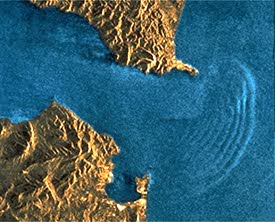
Internal waves are gravity waves which occur at an interface between two layers with different densities (different temperature and/or salinity), whereas surface waves are external gravity waves. These waves result where there is a strong increase in density with depth. Internal waves travel less fast than surface waves. Also less energy is needed to displace the interface from its equilibrium position, and oscillations are more easily set up at the interface than at the surface. This is because the density difference is much smaller than that between air and seawater. Internal waves have greater amplitudes, longer periods and wavelengths than surface waves. Internal waves are crucial in the context of vertical mixing processes in the oceans, especially when they break.
Internal waves can be generated by tidal forces, which interact with topography (over submarine ridges or the continental shelf). They can also be caused by wind or pressure fluctuations or can be induced by a ship (see 'dead water').
Two layer system
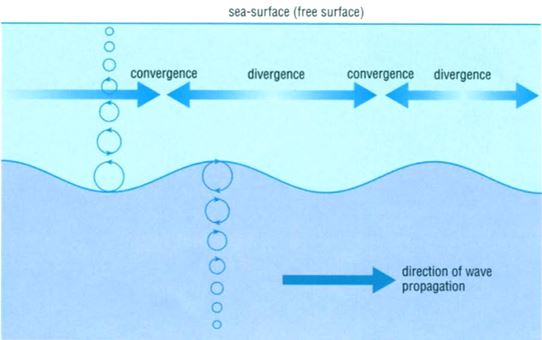
When there are two layers with different densities the orbital motion of the internal wave is in the opposite direction above and below the interface (see figure 2). The upper layer of the internal wave becomes alternatively thinner and thicker when the wave travels along. This leads to divergences and convergences of water at the surface. Undulations of the interface can be detected by satellite because the waves increase the surface roughness where the horizontal flow converges and this increases the scatter of sunlight (see figure 1)
Mathematical description
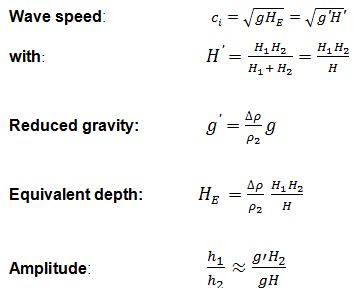

The formula for the wave speed is similar to the one of shallow water waves with g' replacing g and H' instead of H. For surface gravity waves the density of the air is so much smaller than the density of water so that g' is basically equivalent to g. But for internal waves, the difference is much smaller and therefore g' has to be used. Because g' is much smaller than g, the wave speed of internal waves is much smaller than the one of surface waves.
Example: Dead water
The internal waves were discovered due to the occurence of dead water. This phenomenon can occur when a less dense water mass rests on top of denser water without the two layers mixing. This can be found near estuaries in areas where salt water is covered with fresh or brackish water. If a ship sails in such conditions, it generates internal waves at the interface of the two layers when its draft is similar to the depth of the upper layer . The wave speed increases with its amplitude and catches up to the ship. The ship is slowed down until the wave reaches it and breaks. This leads to strong resistance to forward motion and the ship may be hard to maneuver. The same thing happens, when a ship is powered by a propeller. The energy of the ship's propeller results in internal waves and turbulences at the interface, this slows the ship considerably down.

Continuous stratification

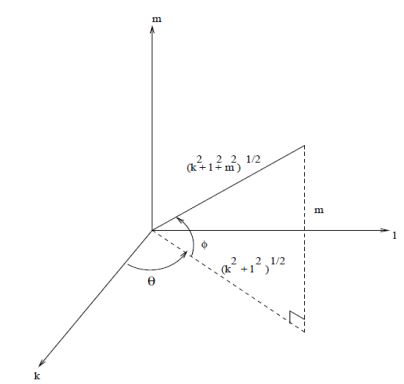
If there is a continuous stratification the dispersion relation shows that:
- The angular frequency ω of the internal wave only depends on the direction of the wave vector but not its magnitude. It is therefore independent of the wavelength.
- ω can be any number between zero and N. The frequency decreases the bigger the angle Φ gets.
- The buoancy frequency N increases as the stratification increases
- The phase velocity is perpendicular to the group velocity, so the wave crests move perpendicularly to the propagation of the wave packet
St. Andrew's cross
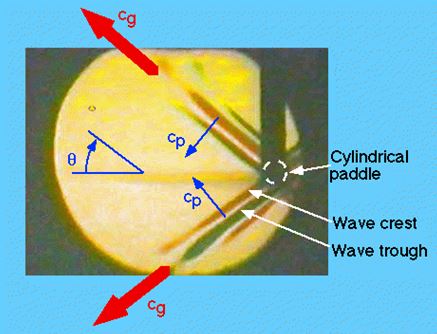
For internal waves, the energy propagates in the direction of the group velocity. If internal waves are generated by a localized source in a stratified fluid, the crests are not circular centered around the source as is the case for surface gravity waves but stretch radially outward from the source.
References
T. R. Akylas & C. C. Mei: Modules on Waves in fluids: Chapter 7: Internal waves in a stratified fluid (http://web.mit.edu/1.138j/www/material/akylas/wm_Chap7.pdf)
Wikipedia (2014): Internal waves: http://en.wikipedia.org/wiki/Internal_wave
Open university (1989): Waves, Tides & Shallow-water processes, Chapter 1.
A. E. Gill (1982): Atmosphere-ocean dynamics, p. 119-139